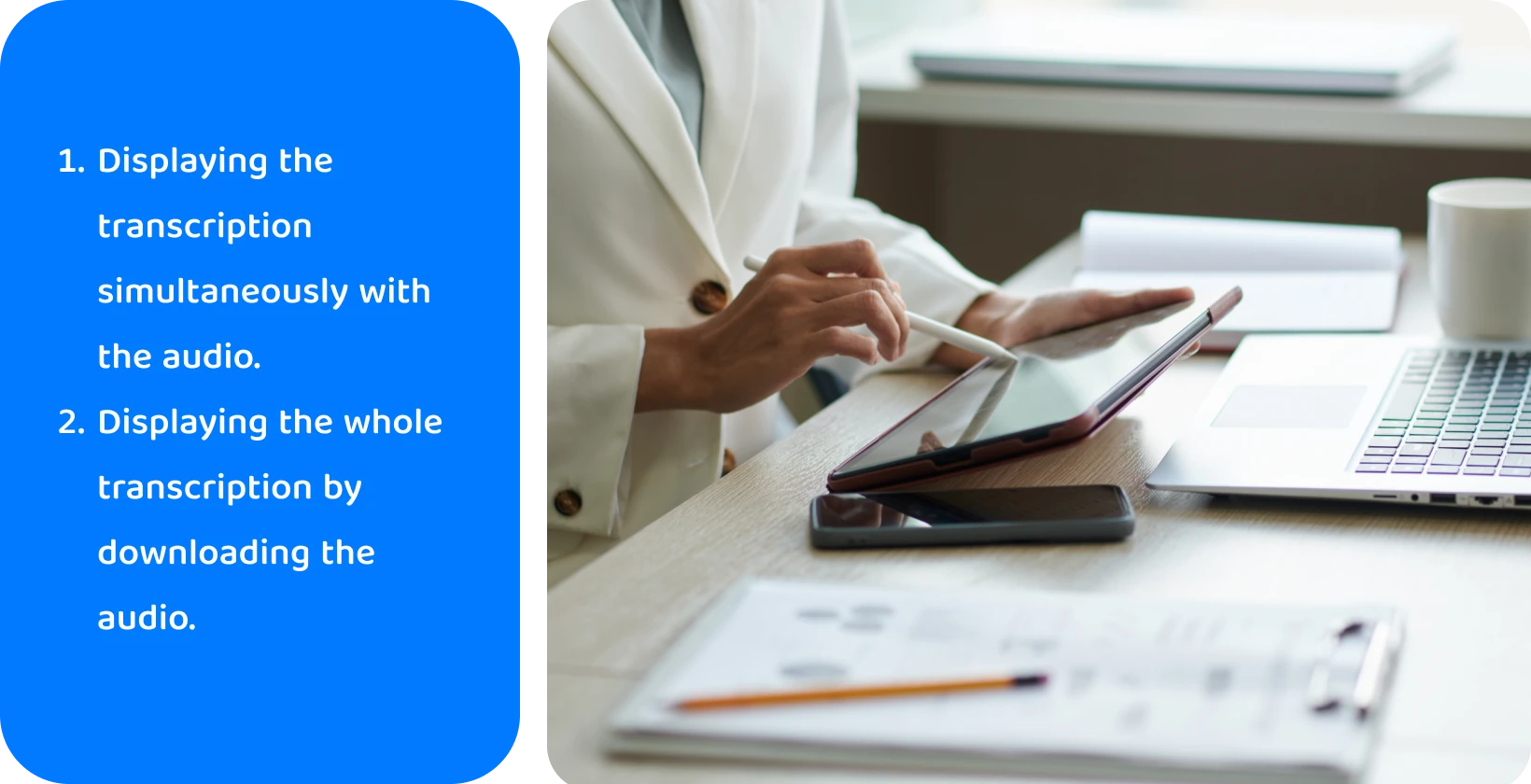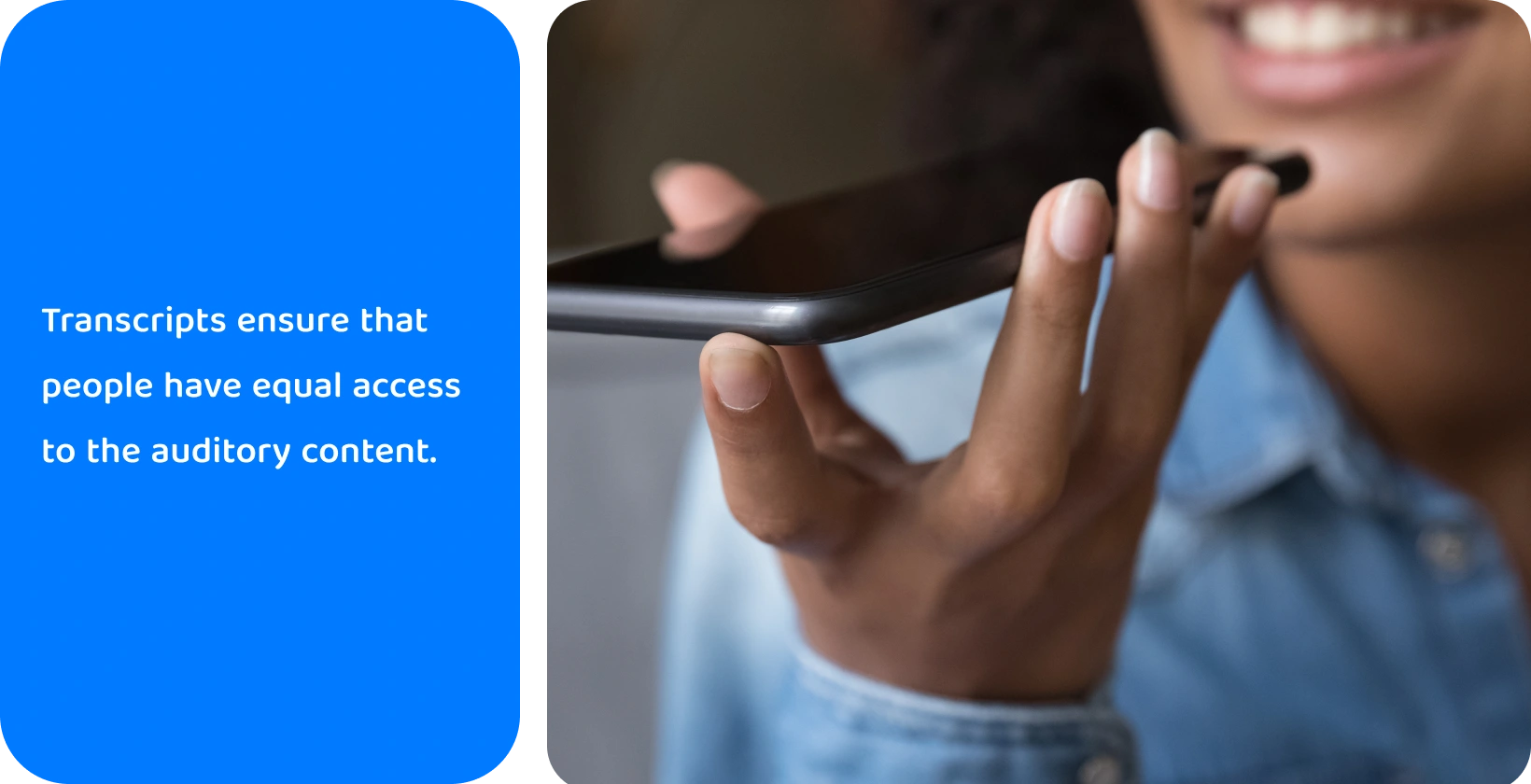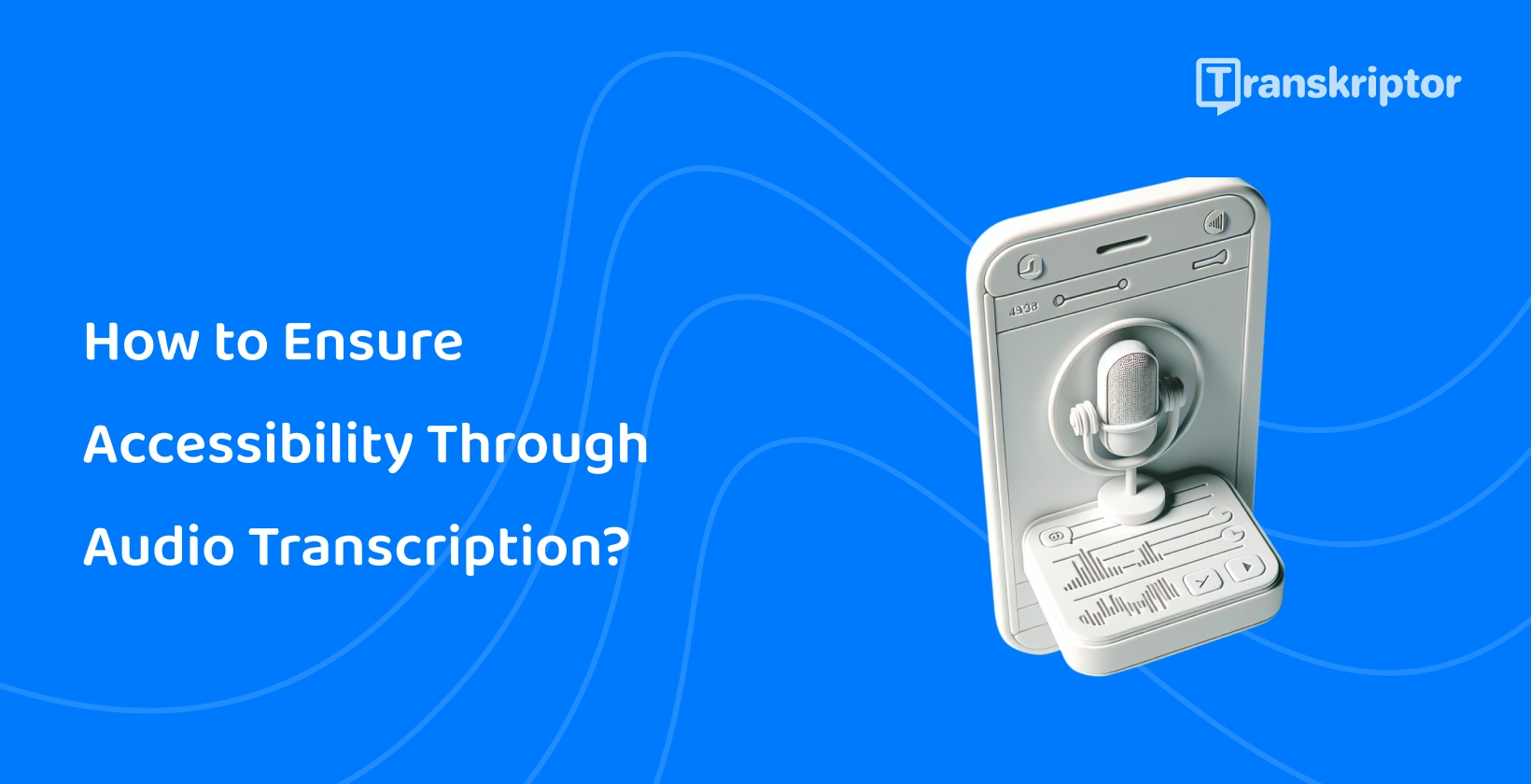Headings, paragraphs, and lists provide navigation in the written content. Users navigate through the text and jump to different sections. Transcription of audio files provides searchable content for the users. Audiences use the “Find” function to search for specific keywords.
Transcription enhances the understandability level of the content. Audio transcription increases the clarity of spoken content. Users who are deaf or with hard-of-hearing prefer audio transcriptions to understand the spoken content better. Users who do not want to listen to the audio content also prefer transcription to follow the content.
The 9 steps for ensuring accessibility through audio transcription are listed below.
- Choose a Reliable Transcription Method: It's essential to select a method that balances accuracy with efficiency.
- Ensure Accuracy and Clarity: The transcript reflects accurately the spoken words without any distortions or omissions.
- Include Relevant Details: Noting important nuances such as speaker identification, emotional tone, and background noises provide depth and context to the transcription.
- Use an Appropriate Transcription Format: Choose the format based on the content's context and the audience's needs to ensure the transcription is easy to follow.
- Add Time Stamps: Including time stamps at regular intervals helps users locate specific parts of the audio in the text.
- Employ Appropriate Punctuation: Correct punctuation is crucial as it affects the readability and interpretation of the text.
- Offer Options for Transcript Display: Providing different formats and display options for the transcript cater to various user preferences and accessibility needs.
- Test and Gather Feedback: Testing the transcription with a diverse audience reveals insights into its effectiveness and areas that may need improvement.
- Update and Maintain Transcriptions: Regular updates ensure that the transcripts remain accurate and relevant, providing ongoing value to users.
1. Choose a Reliable Transcription Method
Choosing a reliable transcription method refers to creating manual transcription, choosing an automated transcription software, and hiring professional transcription services. Manual transcription is time-consuming but it offers a high level of accuracy.
Automated transcription software provides speed and efficiency. Choose a reliable transcription software like Transkriptor . It takes approximately half the time of the audio file for Transkriptor to convert it to text.
Upload the audio to transcription software to get the transcription. The software transcribes the audio in a short time. Be sure that the audio is high-quality and review the transcription afterward.
Professional transcription services offer accuracy and efficiency. These services, however, are more expensive compared to other options. Give the audio to transcribe to the professional transcription services to get fast and highly accurate transcripts.

2. Ensure Accuracy and Clarity
Ensure accuracy and clarity. Proofread the transcription after completing it. Accurate and clear transcriptions improve accessibility and user experience. Compare the audio with the transcript to ensure that they correlate to each other. Errors in transcription result in misunderstandings and misleadings. Ensure that transcription is error-free. Transkriptor can dictate your speeches with up to 99% accuracy.
3. Include Relevant Details
Include relevant details such as background noises and non-verbal sounds to the transcription along with the spoken content. Background noises and other non-verbal elements contribute to the understanding of the context in the audio. These relevant sounds are crucial for people who are deaf or people with hard-of-hearing. Deaf people or people with hard-of-hearing follow the written content instead of the auditory content.
4. Use an Appropriate Transcription Format
Use an appropriate transcription format for the content. Ensure that the format is accessible to users on different devices. Some transcription formats do not work on screen readers or tablets. Structure a logical transcription with clear headings and short paragraphs
Choose a readable and clear font and text style. Avoid overly ornate text styles. Be sure that the format is accessible for the audience. Transkriptor supports various audio formats. Once uploaded, the service will process the audio using speech recognition technology to create a transcription. Transkriptor supports all audio and video file formats as input (MP3, MP4, WAV, AAC, M4A, WEBM, FLAC, OPUS, AVI, M4V, MPEG, MOV, OGV, MPG, WMV, OGM, OGG, AU, WMA, AIFF, OGA).
5. Add Time Stamps
Add timestamps to the audio transcription. Time stamps indicate the exact time of each word and sentence in the audio. Time stamps provide navigation and users jump to specific parts of transcription by using time stamps.
6. Employ Appropriate Punctuation
Employ appropriate punctuation to the audio transcription. Punctuation increases the readability and comprehension level of the transcription. Punctuation also conveys the tone, pace, and pauses in the spoken content. Transcription is not clear if there is no appropriate punctuation.

7. Offer Options for Transcript Display
Provide options for transcript display to the users. Transcription displays have 2 kinds. The first one is displaying the transcription simultaneously with the audio. This type of display gives short parts of transcription along with the audio. The second option is displaying the whole transcription by downloading it. Displaying the whole transcription gives the whole transcription at once.
8. Test and Gather Feedback
Test and gather feedback. Test the audio transcription and ask for feedback from other people. Check if there are any errors in the transcription and edit these errors.
Use the feedback to make improvements. Make someone else check the transcription as other people read the transcription more objectively.
9. Update and Maintain Transcriptions
Update and maintain transcription if the audio is changed or corrected. Ensure that the transcription suits the audio content. Be sure that the transcription is accessible for users after a certain time.
Make the changes on the transcription. Not updating the transcript regularly results in inconsistency in the transcript.

Why is Audio Transcription Important for Accessibility?
Audio transcription is important for accessibility because it provides inclusivity, enhanced understanding, flexibility, and searchability. Audio transcripts make audio content accessible for users who are deaf or who have hard-of-hearing. Transcripts ensure that people have equal access to the auditory content.
Transcription of audio enhances the understanding level of the users. Transcriptions provide clear and concise written formats of the audio. Users with learning disabilities or attention deficits prefer transcriptions to follow the content.
Audio transcripts provide flexibility in content consumption. Users have different learning styles and some of them prefer reading text rather than listening to audio. Transcripts give flexibility for these kinds of users.
Audio transcripts make the content searchable. Users find the specific parts of a content by using transcription. Timestamps in transcription allow users to navigate the parts of the audio content.
What are the Benefits of Transcriptions for Audio Content?
The benefits of providing transcriptions for audio content are listed below.
- Increased Accessibility: Transcriptions make audio content accessible to users who are deaf or users with hard-of-hearing.
- Enhanced Learning and Comprehension: Users who learn by reading the content instead of listening to it use transcriptions. Reading along with the audio enhances the learning and comprehension level of the users.
- Improved User Experience: Transcription provides options for users to consume the content. Users choose how to engage with the content. This improves the user experience.
- Searchability and Navigation: Transcribed content is easy to search within. Transcription helps users to locate specific parts of the content. Users also choose and jump to the specific parts they want to listen to.
- Accuracy and Clarity: Audio transcripts allow users to comprehend the content more accurately and clearly.
What Challenges Can Arise in Implementing Audio Transcription for Accessibility?
The challenges that can arise in implementing audio transcription for accessibility are listed below.
- Accuracy and Quality: Transcriptions of poor-quality audios cause low levels of accuracy and quality. Automatically created transcriptions have some mistakes on specific and uncommon terminology.
- Technological Challenges: Automated transcription services give inaccurate transcriptions in complex audios. Current technology does not support all languages, dialects, or accents. These restrictions cause inaccurate transcriptions.
- Compatibility Issues: There are platforms and media players that do not support transcription formats. Integration and compatibility issues also arise with screen readers. Transcription does not appear accurately if the device does not support the format.
New Levels of Accessibility: Transkriptor's Role in Audio Transcription
Transkriptor significantly boosts accessibility by providing a seamless audio-to-text transcription service that caters to diverse needs. This advanced platform automates the conversion of spoken words into written form with exceptional accuracy, addressing the crucial aspects of accessibility: navigation, searchability, and understandability.
By integrating Transkriptor into the transcription workflow, content creators and professionals can significantly enhance the efficiency of their processes. This not only saves valuable time and resources but also elevates the quality of transcriptions, making digital media more inclusive and accessible to a broader audience. Try it now !


